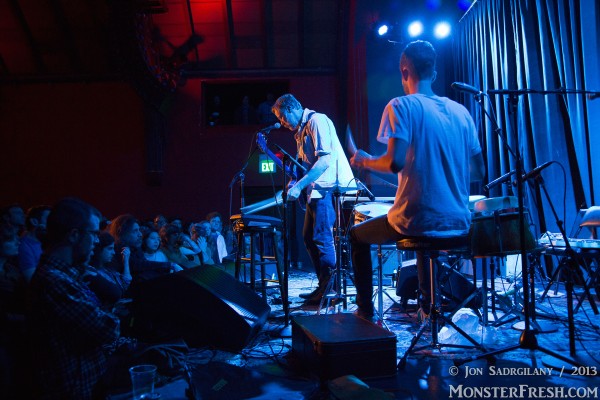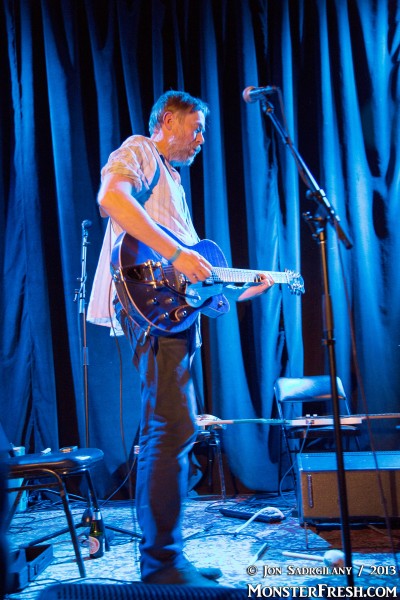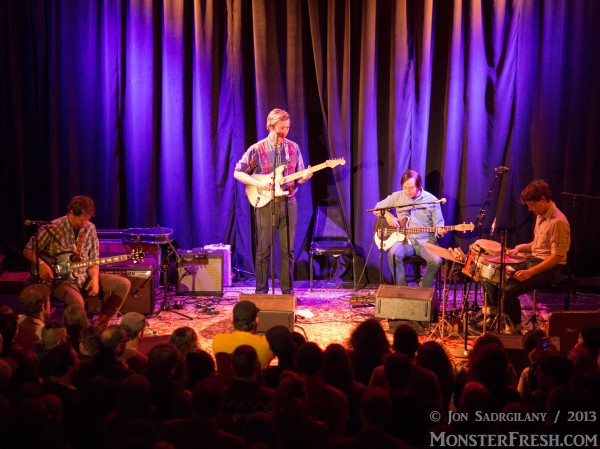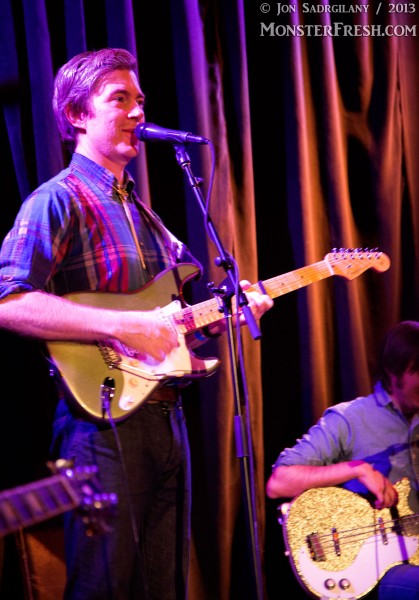By Land and By Sea: Bill Callahan and Mick Turner @ The Chapel [SF]
The Drag City songsmith hits the road to promote his latest release, Dreamer River, on a tour with labelmate & Dirty Three guitarist Mick Turner as the opener.

Bill Callahan
Mick Turner
The Chapel
San Francisco, CA
10. 13
Music serves many purposes.
[Curse me all you want for starting a show review with a vague, meaningless statement that has as many interpretations as reasons to dismiss it entirely, but bear with me, just a moment longer.]
Early forms incited rhythm or awe–the tribal poundings of collective dance or the delicate harmonies of godlike orchestrations. By the time that rock and roll sank it’s teeth into the mainstream, groups were as likely to freak listeners out as make them move, songs often constructed as conceptual pieces rather than instinctual outpourings. Now, with all of the pop flash and indie experimentation, it’s easy to lose track of subtler, more specific artists working on something else entirely.

Residing in that quieter side of the spectrum, the music of Bill Callahan and Mick Turner, more than anything, paints landscapes: dusty roads and endless prairie, choppy seas and the salted people who populate those lonesome locales. In Callahan’s case, there’s a heavier lean on rootsy wisdom, wry humor, and the characters that dispense both, but both artists evoke wilderness and our winding paths into, through, and over it.
Of course, these are individual artists with lengthy careers full of left turns, collaborations, and reinventions, and their bodies of work cannot be pared down to a convenient rhetorical descriptor. Still, in their current iterations, as I bore witness to not three weeks ago, the bulk of their sets induced audio charged visions of oceans, deserts, and all of the rattle and roll between.
While this sort of material could have easily been choked out in a lesser context–some festival side stage or inattentive ballroom–I had the privilege of catching the tour at The Chapel, one of my favorite venues in San Francisco, prized for its limited capacity, vaulted ceilings, and impeccable acoustics. What’s more, typical crowds display more reverence than rabble rousing, lending the room a hushed, religious spirit; really, the ideal place for this kind of concert.

Mick Turner started the evening off slowly; so quietly that the crowd didn’t even notice that his first cymbal taps and guitar strums were anything more than sound check. Building organically from faint beginnings, the 53 year-old guitarist was joined onstage by only a loop pedal and a drummer, yet his foundational lines and overlaying noodling filled the space entirely. Over the course of each track, his fret play evolved from atmospheric touches to crescendo crashing solos, accented by whatever additional instrument seemed to catch his fancy.
 In perhaps the most charming and telling moment of the night, Turner let the loop roll unadulterated while he shuffled through potential accompaniments. First picking up a bow, measuring it against the guitar, as if to add a cello indebted blast, he set it aside in favor of a melodica, blowing faintly into the mouthpiece and tapping out an airy rhythm on the keyboard. While his live presentation certainly reflected that of his recorded material, his clear improvisation and joyful approach breathed new depth into his work.
In perhaps the most charming and telling moment of the night, Turner let the loop roll unadulterated while he shuffled through potential accompaniments. First picking up a bow, measuring it against the guitar, as if to add a cello indebted blast, he set it aside in favor of a melodica, blowing faintly into the mouthpiece and tapping out an airy rhythm on the keyboard. While his live presentation certainly reflected that of his recorded material, his clear improvisation and joyful approach breathed new depth into his work.
Best known as the guitarist for the Australian instrumental rock band Dirty Three, Mick Turner has also contributed work to assorted Will Oldham projects over the years, as well as Cat Power’s seminal 1998 release, Moon Pix. His signature style is two notches above ambient–breezy picking and crashing chords played with a post-rock detachment, a spacious take on the vaguely psychedelic Americana sound. He normally has a far larger palette to work with, a point he called attention to between songs (“I couldn’t afford to bring the horn section”), but even on his lonesome, Turner spit out more layers of interwoven shredding than most modern guitar acts.
The songs danced the line between airy daydreams and creaky nightmares, the haunting loops drifting in and out of the mix; the quietly complex arrangements spinning into self-appointed cacophony. Everything from his latest release, Don’t Tell the Driver, rang with the same richness as the record, but the highlight came in what Turner pre-empted as an “Australian folk song.” Building up from runaway cymbal taps and an approximated bass line, his overlaying riffs hit new heights when he switched fingers for a drumstick, screeching out the sonic vision of a train. At one with his drummer, moving through each passage with a shared, unspoken knowledge, a minimalist Neil Young solo wound into an engine roar and twang, falling apart with an unceremonious ending: “Bill will be here soon.”
Picking up before slack could enter the picture, Bill Callahan and his band took the stage and launched straight into a tightly rollicking cover of “White Light/White Heat,” capturing the jolt of the Velvet Underground‘s original and infusing it with a bit of down home grace. Ever the Southern gentleman, Callahan exuded a stately yet subdued charm, managing to make even his distortions sound polite. Dressed in an ensemble that bespoke a PTA board member more than a rock star, the songwriter and his backing four-piece band were all business from the start, excepting a stray wink or two.

Despite how well this cap fits, Bill Callahan hasn’t always veered this close to a smoked out Leonard Cohen; the 47 year-old singer songwriter has come a long way from his noisy, lo-fi roots, his early albums–recorded as “Smog“–full of bizarre blips and fuzzy feedback. Those experimental sonics still find their way into his work, but now they serve as jarring contrasts to established melodies, not the structures themselves. As strong as that early work was, Callahan sounds as powerful as ever, both vocally and musically, on his last two records, Apocalypse and Dream River.
My entry point was Apocalypse, the 2011 release that first brought his music to my attention, so I’ll freely admit my bias in holding it as his high water mark, along with a few favorite Smog albums. The perfect soundtrack to a long drive into the woods and a season ending bonfire, with plenty of bumps of blazes in between, the peak of the album is one of its mellowest moments: “Riding for the Feeling.” Over a slow strum, distant twang, and sunken organ, Callahan breezes observations on leaving, traveling, and maybe never getting there; hinting at a world where the only point in moving is the instant rush of the wind. Snaking into himself, he sits in a hotel room, listens back to his tapes, and finds his apocalypse–not the world’s, simply his own. When he unrolled it live, the immediate highlight to my prejudiced ears, the central melody and vocal tone were intact, but the most striking touches were the small pockets of distortion, rolling off the song like gently fraying tumbleweeds.
 Despite the apparent sadness in this–and really, most of his work–Bill performs with an earnest contentment, secure in his place on stage, with nothing left to prove or strive for. He’s not done kicking–not by a long shot–but he’s rode the wild, young colt down into a wise, seasoned stallion. It’s apparent in his self-assured scans across the room, his fatherly smile towards his feedback swirling guitarist, Matt Kinsey, the gently playful banter between songs–Callahan is happy.
Despite the apparent sadness in this–and really, most of his work–Bill performs with an earnest contentment, secure in his place on stage, with nothing left to prove or strive for. He’s not done kicking–not by a long shot–but he’s rode the wild, young colt down into a wise, seasoned stallion. It’s apparent in his self-assured scans across the room, his fatherly smile towards his feedback swirling guitarist, Matt Kinsey, the gently playful banter between songs–Callahan is happy.
That emotional destination isn’t wholly reflected in his latest release, Dream River, but nothing’s ever that straightforward with a cagey poet like Callahan. After beginning and ending in a dream, he spends the rest of the album in domestic bliss, darkened barrooms, and seaside apocalypses, his dry observation spun into weighty wisdom with the added oomph of his commanding baritone. His playful word choice, often inventive but never pretentious, is on full display in “Spring” when he sings, “The mountains don’t need my accolades/ And spring looks bad lately anyways,” circling back to find that, “The true spring is in you”–all this, while jazzy flutes, spiraling guitars, and bongos vie for turns in the foreground. When he concludes, as the instruments come crashing together, with, “All I want to do is to make love to you/ In the fertile dirt, with a careless mind,” the artist has never sounded so convincing.
Throughout the show, the frontman held the crowd in rapt attention, their transfixed sways only broken by the odd catcall or shoulder shift to a particularly upbeat track, like “America.” Surprisingly intimate, even for a cozy joint like the Chapel, he gave the impression that we were all in his living room–maybe his barn–invited over for a few whiskeys and stories, both old fashioned. After stretching the set to its natural conclusion, Callahan introduced each band member for a spotlight solo, thanked us kindly, and exited the stage, to our immediate shock and disapproval. Frantic, pleading, calling for more, we shouted encore, and he turned, almost as if to say, “I wish I could,” knowing full well that he wouldn’t.
He’s a man of the people, making music of the land, the fields, the roads stretching across this country, and every other lonely place. Once a reckless and noisy artist, now an aged and powerful sage, Bill Callahan has come full circle to the place he never thought existed: home.